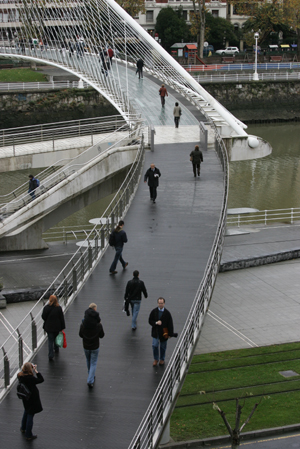
The curving glass deck of Calatrava’s 250-foot-long footbridge is suspended by cables from a tilted arch; Isozaki’s work, in contrast, introduces solid paving, different balustrades, and a conventional concrete structure. The addition spans a boulevard and allows pedestrians to reach the bridge without descending and re-ascending flights of stairs. The city commissioned the 200-foot extension as part of the urban plan for Isozaki’s new 320-unit complex of apartment buildings, which faces the river, including two 270-foot-tall glass towers that frame views of Calatrava’s bridge.
In his ruling, judge Edmundo Rodríguez Achútegui recognized that Calatrava’s rights as author of the bridge had been infringed, but he ruled that the public utility of the addition took precedence over this private right. “In addition to constituting a singular artistic creation suitable for protection, the work is public one, offering a service to the citizens, and thus satisfies a public interest,” he said. “If we weigh these interests, the public must prevail over the private.”
Nevertheless, the judge added that he found it “incomprehensible” that the city failed to consult Calatrava or seek his participation. He ordered both sides to pay the costs of the trial, which are as yet undetermined, a measure usually reserved for the loser of a civil case in Spain. His sentence also permits an appeal, which Calatrava’s lawyers have already filed, although a spokesperson for the architect said that the decision as it stands represents a “moral satisfaction.”
The ruling raises questions about the application of Spain’s 1996 Law of Intellectual Property to works of architecture and engineering. The law establishes the rights of the creators of artistic, literary, and scientific works, including the protection of their physical integrity. While it specifically excludes buildings and engineering works from protection, the judge’s decision to interpret Calatrava’s project under the law’s broader definition of a work of art puts this limitation into question. Although the Judge agreed to consider Calatrava’s private interest in the integrity of his work, nowhere in the trial was the public interest in this integrity addressed. But as local architect Javier Mozas told the Spanish newspaper El País, “If the law is fully applied to buildings, no one could touch even a window.”
Another longstanding conflict over the Calatrava bridge concerns its deck, which consists of 560 glass pavers that are slippery when wet and frequently break. Bilbao mayor Iñaki Azkuna says that the city has had to replace all of the pavers at least once over the past 10 years, at a cost of at least $300,000—which some observers point out is not a particularly excessive amount—and, more seriously, that it faces lawsuits for injuries resulting from falls. He alleges that Calatrava has rejected proposals to replace the paving, while the architect has defended the glass as an essential element of his design. The city has applied anti-slip tapes to the glass for greater traction and will study options for a more permanent solution pending the final resolution of Calatrava’s appeal.




Post a comment to this article
Report Abusive Comment